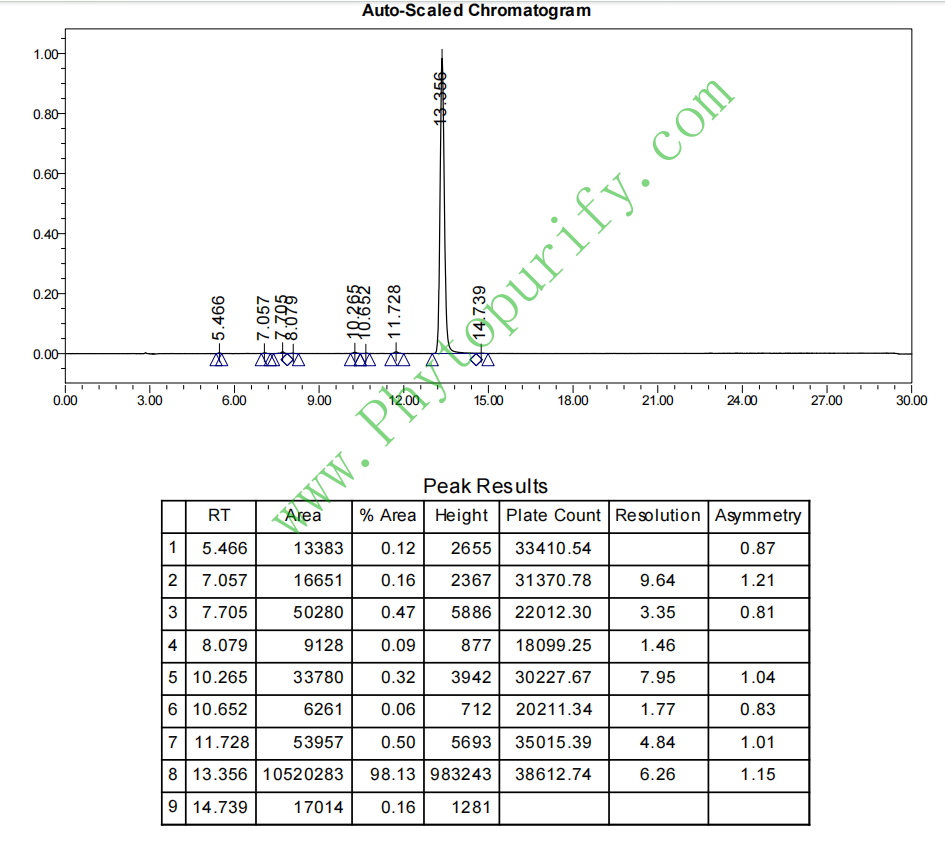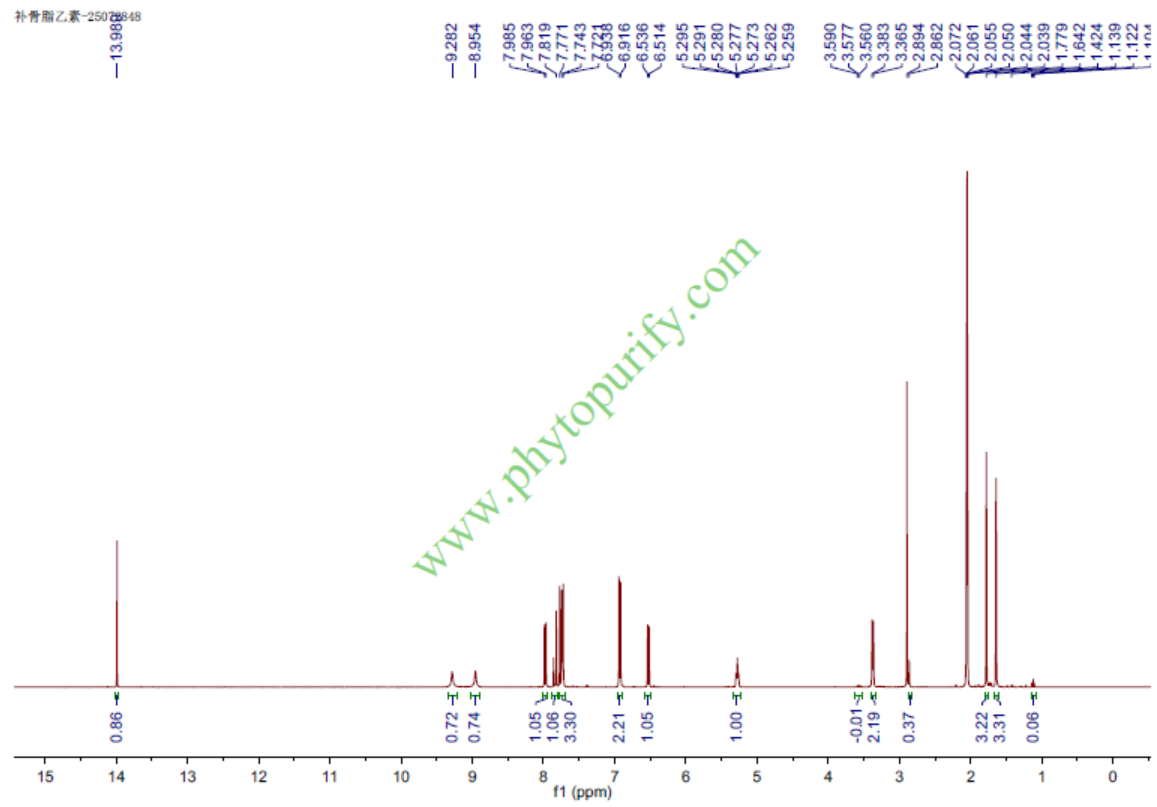
IsobavachalconeCAS No.:20784-50-3
|
||||||||||
 |
|
|
||||||||

| Catalogue No.: | BP0773 |
| Formula: | C20H20O4 |
| Mol Weight: | 324.376 |
Synonym name: Corylifolinin; Isobacachalcone; Isobavachalcone
Catalogue No.: BP0773
Cas No.: 20784-50-3
Formula: C20H20O4
Mol Weight: 324.376
Botanical Source: Artocarpus lowii, Psoralea corylifolia and Lonchocarpus sp. Also callus culture of Glycyrrhiza uralensis
Purity: 95%~99%
Analysis Method: HPLC-DAD or/and HPLC-ELSD
Identification Method: Mass, NMR
Packing: Brown vial or HDPE plastic bottle
Can be supplied from milligrams to grams.
For Reference Standard and R&D, Not for Human Use Directly.
Inquire for bulk scale.
Description:
Isobavachalcone has anti-cancer, anthelmintic, antibacterial, aphrodisiac, anti-inflammatory, astringent and antiplatelet activities, Isobavachalcone can induce apoptotic cell death in neuroblastoma via the mitochondrial pathway; it can significantly inhibit both oligomerization and fibrillization of Aβ42; it can suppress inducible nitric oxide synthase (iNOS) expression induced by macrophage-activating lipopeptide 2-kDa, polyriboinosinic polyribocytidylic acid, or lipopolysaccharide.
References:
Eur J Pharmacol. 2015 May 5;754:11-8.
Isobavachalcone attenuates lipopolysaccharide-induced ICAM-1 expression in brain endothelial cells through blockade of toll-like receptor 4 signaling pathways.
Inflammation has been implicated in the pathogenesis of various cerebral diseases. Thus, control of brain inflammation is regarded as one of the important therapeutic strategies for the treatment of neurodegenerative diseases such as Alzheimer׳s disease and stroke. Isobavachalcone, a flavonoid from Psoralea corylifolia, is known to possess a wide spectrum of biological activities and is expected to be useful in preventing or treating neurodegenerative diseases. However, very little is known regarding its effects on cerebral inflammation.
METHODS AND RESULTS:
In this study, we examined the effect of Isobavachalcone on leukocyte adhesion and intercellular adhesion molecule-1 (ICAM-1) expression in brain endothelial cells activated with lipopolysaccharide (LPS) and explored the possible mechanisms involved. Isobavachalcone significantly down-regulated LPS-induced ICAM-1 expression and leukocyte-endothelial cell adhesion and suppressed NF-κB activity which is implicated in the expression of ICAM-1. It attenuated ICAM-1 expression as well as NF-κB transcriptional activity induced by macrophage-activating lipopeptide 2-kDa (MALP-2) or polyriboinosinic polyribocytidylic acid (poly[I:C]). Isobavachalcone also down-regulated LPS or poly[I:C]-induced expression of IFN-β, which can indirectly activate NF-κB. These data imply that Isobavachalcone can modulate both MyD88-dependent and TRIF-dependent signaling of toll-like receptor 4 (TLR4).
CONCLUSIONS:
Taken together, our data suggest that Isobavachalcone inhibits LPS-induced ICAM-1 expression and leukocyte adhesion to brain endothelial cell by blocking TLR4 signaling and thus, has the potential to ameliorate neuronal injury in brain diseases associated with inflammation.
Int J Mol Med. 2012 Oct;30(4):939-44.
Autophagy inhibition enhances isobavachalcone-induced cell death in multiple myeloma cells.
Despite recent advancements in therapeutic drugs, multiple myeloma remains an incurable disease.
METHODS AND RESULTS:
Therefore, a more effective treatment is urgently required. In this study, we show that Isobavachalcone (IBC), a natural chalcone compound, induces apoptosis- and autophagy-related cell death in myeloma cells. The inhibition of autophagy by knocking down beclin-1 or by using autophagy inhibitors, such as 3-methyladenine, bafilomycin A and chloroquine significantly enhanced IBC-induced cell death, as demonstrated by the increased number of Annexin V-positive cells. Moreover, we demonstrate that the collapse of the mitochondrial membrane potential contributes to chloroquine and IBC-induced cell death, which is accompanied by the activation of caspase-9, and -3, the cleavage of poly (ADP-ribose) polymerase (PARP) and the proteolytic activation of protein kinase Cδ (PKCδ). Furthermore, the inhibition of the activation of PKCδ by rottlerin, an inhibitor of PKCδ, not only suppressed the activation of PKCδ, but also the apoptosis induced by the co-treatment of chloroquine and IBC, indicating the involvement of PKCδ in chloroquine plus IBC-induced cell death. Finally, the combination of chloroquine and IBC had little effect on the viability of normal peripheral blood mononuclear cells.
CONCLUSIONS:
As both chloroquine and IBC have been shown to be relatively specific for cancer cells, the combination of these two agents at non-toxic or sub-toxic concentrations represents an attractive novel regimen for myeloma treatment and warrants further investigation in preclinical and clinical studies.
Antimicrob Agents Chemother. 2010 May;54(5):1749-52.
Efflux pumps are involved in the defense of Gram-negative bacteria against the natural products isobavachalcone and diospyrone.
The activities of two naturally occurring compounds, Isobavachalcone and diospyrone, against documented strains and multidrug-resistant (MDR) Gram-negative bacterial isolates were evaluated.
METHODS AND RESULTS:
The results indicated that the two compounds exhibited intrinsic antibacterial activity against several Gram-negative bacteria, and their activities were significantly improved in the presence of an efflux pump inhibitor (MIC values decreased to below 10 microg/ml). In addition, the activities of Isobavachalcone and diospyrone against various strains exhibiting deletions of the major efflux pump components (AcrAB, TolC) were significantly increased.
CONCLUSIONS:
The overall results indicate that Isobavachalcone and diospyrone could be candidates for the development of new drugs against MDR strains and that their use in combination with efflux pump inhibitors reinforces their activity.
Cancer Lett. 2010 Aug 28;294(2):167-77.
Abrogation of Akt signaling by Isobavachalcone contributes to its anti-proliferative effects towards human cancer cells.
Akt signaling pathway has attracted much attention as a promising target for cancer therapeutics. Herein, we report that Isobavachalcone (IBC), a natural chalcone, potently abrogates Akt signaling and exerts anti-proliferative effects on several human cancer cell lines.
METHODS AND RESULTS:
Modeling results from the Sybyl/FlexiDock program suggest that IBC potentially binds to the ATP-binding pocket of Akt, which is confirmed by the observations that IBC inhibits Akt1 kinase in vitro. Further studies reveal that IBC significantly abates Akt phosphorylation at Ser-473 and Akt kinase activity in cells, which subsequently leads to inhibition of Akt downstream substrates and evokes significant levels of apoptosis associated with mitochondria pathway.
HPLC of Isobavachalcone

HNMR of Isobavachalcone
